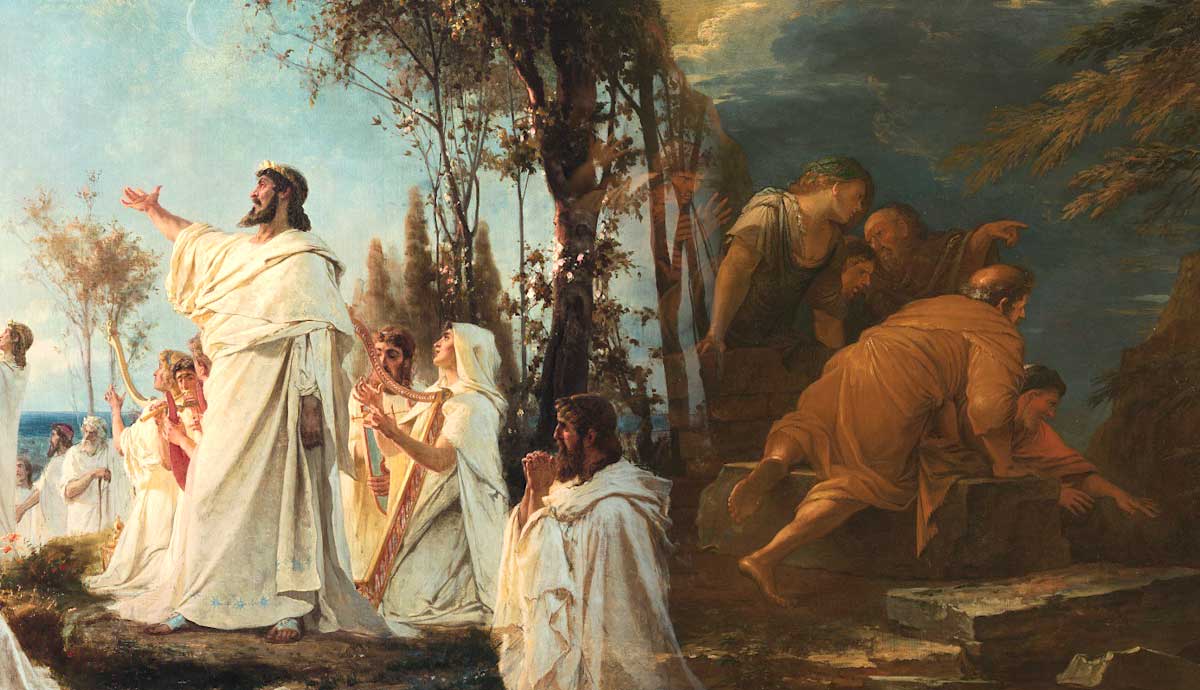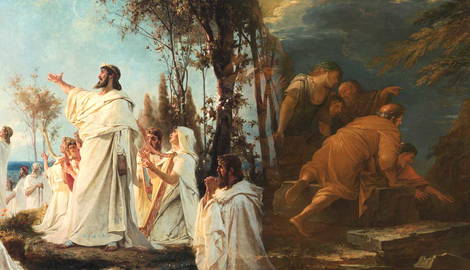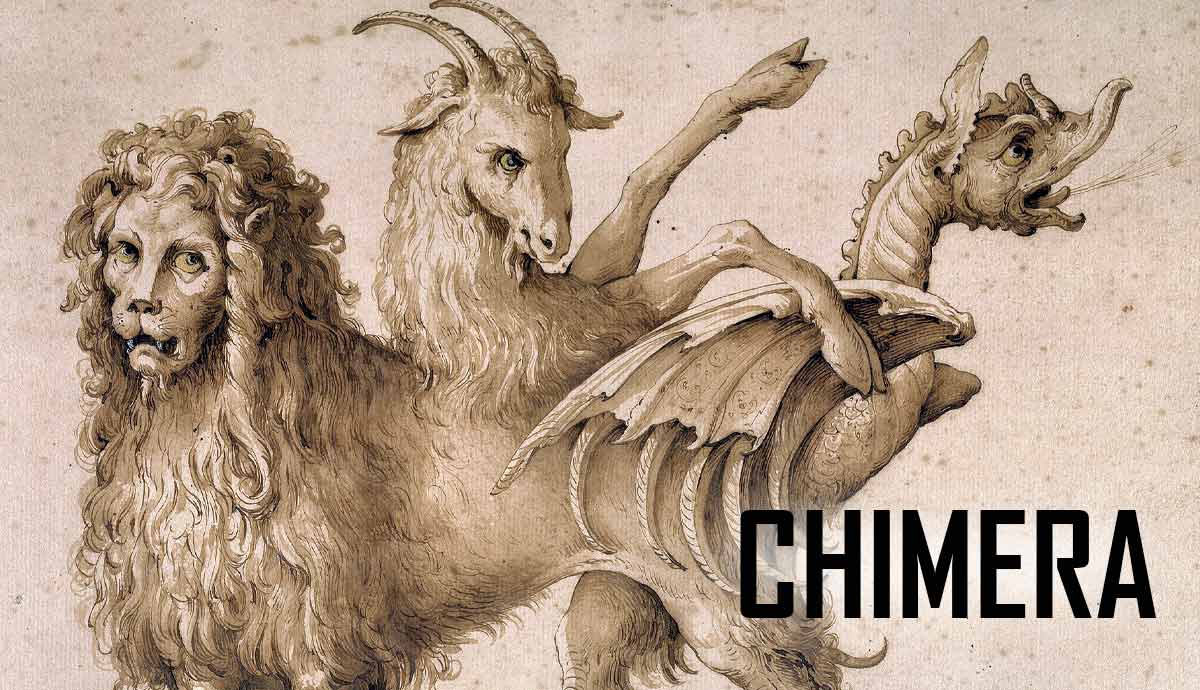
Established in the 6th century BCE, Pythagoreanism was a philosophical school and a religious movement based on the beliefs and teachings of its enigmatic founder, Pythagoras, and his followers — the Pythagoreans. The name Pythagoras should be familiar to you, and it may remind many of their high school maths classes, how do you find the hypotenuse? The answer is the Pythagorean Theorem: a²+b²=c².
Society remembers Pythagoras as a mathematician and not as a charismatic cult leader. However, the two go hand in hand. Pythagoras believed in sacred mathematics and thought that the universe could be understood through numbers. Pythagoreanism was more than a cult of numero-philes. They believed in metempsychosis (reincarnation), embraced an egalitarian communal lifestyle, and practiced a rigid set of daily rituals and dietary restrictions. The cult also believed in universal music or harmony of the spheres, wherein it was believed that the movements of celestial bodies were a form of music.
Who Was Pythagoras?

Pythagoras of Samos was born around 570 BCE to Mnesarchus, a gem-engraver, and Pythias, a descendant of the wealthy and aristocratic Geomori family. The Syrian philosopher Iamblichus reports that the young couple traveled to Delphi to consult the Pythian oracle while Pythias was pregnant. The Oracle declared that their child would be a supremely beautiful and wise man that would benefit humanity.
Ancient sources report that Pythagoras was educated by a variety of legendary pre-Socratic philosophers such as Pherecydes of Syros, Anaximander, and two of the seven sages Bias of Priene and Thales of Miletus. Other traditions claim that Pythagoras was trained by the mythic Orpheus and that he was one of the first to be initiated into the Orphic mysteries.

During his early adulthood, Pythagoras traveled throughout the Near East, reportedly going to Babylonia, Phoenicia, and Egypt. Accounts of Pythagoras traveling to Babylonia and Phoenicia are heavily disputed, but all accounts agree that he traveled to Egypt. Pythagoras studied with Egyptian priests in Thebes and became the only foreigner we know of to be granted the privilege of participating in their worship. There is a consensus that Pythagoras learned the foundations of geometry, mathematics, and metempsychosis while studying in Egypt.
The motivation behind Pythagoras’ extensive travels was not simply to learn but specifically to gain spiritual wisdom. He was fascinated by religious phenomena, undergoing initiations into the Eleusinian Mysteries, and reportedly studying with the Zoroastrian Magi priests and learning moral philosophy from the Delphic priestess Themistoclea.
Life in Samos

After his travels, Pythagoras returned to Samos and established a school called the Semicircle. The school attracted the brightest minds of ancient Greece, and the core philosophical principles of Pythagoreanism likely developed within the Semicircle.
However, the Semicircle was not the origin of the cult of Pythagoras, nor was the Pythagorean way of life ever practiced within its walls. Pythagoras left Samos in 530 BCE. Pythagoreans claim he left because he disagreed with Samos’s tyrannical leader, Polycrates, who had seized power five years earlier. While others report he left because he felt overwhelmed by his newfound public duties and teaching obligations.
The Commune in Kroton

At the age of 60, Pythagoras emigrated to the Greek colony of Kroton in southern Italy. Like all cult leaders, Pythagoras was charismatic and a skilled public speaker. He quickly garnered over a thousand eager followers and, with their help, established the first Pythagorean commune. The Pythagorean commune and its new way of life flourished under Pythagoras’ leadership for years. However, it would not last as the cult’s growing political influence created powerful enemies that instigated the group’s demise.
In 510 BCE, Pythagoras and his followers helped Kroton win a decisive victory against the neighboring city of Sybaris. Afterward, the people of Kroton proposed establishing a democratic constitution, which Pythagoras shut down using his political influence. Pythagoras and his entire commune periodically held meetings in the home of Olympic athlete and Pythagorean Milo. During one such meeting, the enraged pro-democrats set Milo’s home on fire, hoping to kill Pythagoras and all his followers in one conclusive act of vengeance.
Death

Sources disagree as to what happened next. Some believe that Pythagoras was present and either died or escaped at the cost of many of his followers. Thereafter, Pythagoras and his followers fled to the city of Metapontum, finding asylum at the temple of the Muses. However, without food or water, Pythagoras and the survivors died 40 days later. Others claim that after escaping the fire, Pythagoras committed suicide due to the insurmountable grief of losing so many followers.
Later Pythagoreans believed that Pythagoras almost managed to escape but encountered a fava bean field and refused to cross it as the Pythagoreans believed beans were sacred. He was quickly found and executed for his final act of piety.
The Legacy of Pythagoras: Discoveries

Numerous discoveries in the fields of mathematics, music, and astronomy are attributed to Pythagoras. However, historians dispute the idea that Pythagoras made any meaningful contributions to mathematics, music, or science. Historical evidence proves that Pythagoras’ most famous discovery, the Pythagorean Theorem existed centuries before his birth in Babylonia and ancient India. Although it is possible that he learned of it during his travels and was the first to introduce it to the ancient Greek world.
Later Pythagoreans claimed that Pythagoras was the first to identify the five regular solids and that he discovered the theory of proportions and how to translate music into mathematical intervals and octaves. Historians dispute how much Pythagoras discovered and what was attributed to him by later Pythagoreans aiming to bolster his legend and authority. It was likely a bit of both, and Pythagoras probably did lay the foundations for the theory of proportions and its implications for musical theory.
Man of Miracles

The Pythagoreans present Pythagoras as a divine prophet — not something unexpected of a founder of a new religious sect. They claimed that he could predict the future, that he had a golden thigh, and that a river once spoke to him. Others reported that Pythagoras traveled to the underworld and recounted exactly what people had been up to during his descent upon his return.

Pythagoreans reported that Pythagoras could remember all his past lives. He recalled being Aethalides, son of Hermes, who gifted him the ability to remember everything in both life and death. He was reborn as Euphorbus and slain during the Trojan war. Next, he was Hermontimus, then Pyrrhus — a fisherman from Delos, and finally Pythagoras. The story helped corroborate his theory of metempsychosis and presented him as an ancient figure who possessed divine knowledge older even than Hesiod and Homer. It is unlikely that Pythagoras himself perpetuated these claims, and it was probably the work of later Pythagoreans trying to establish him as an authority on the mystical and divine.
The Philosophy of Pythagoreanism

The core belief of Pythagoreanism was that the universe and all things within it were made by numbers, and thus everything could be counted. Pythagoras believed that through numbers, the universe and all its secrets could be revealed and understood. Unlike their contemporary Greek mathematicians who represented numbers through words, the Pythagoreans used pebbles to display their mathematics in groups of triangles. This new visual understanding allowed for the exploration of numbers and their relationship to geometry and proportion.
Pythagorean Numerology

Pythagoras believed only in natural numbers (positive numbers) as the concept of zero had yet to make its way to ancient Greece from India. The idea of negative numbers was blasphemy. Hippias, a student of Pythagoras, reportedly discovered irrational numbers, and Pythagoras supposedly murdered him to protect his mathematical principles.
The Pythagoreans believed numbers held a mystical quality and attributed abstract ideas and concepts to certain numbers. The number one symbolized divine intellect, unity, and the origins of the universe and everything within it. While the number two symbolized thought and matter. The Pythagoreans placed great significance on the number three. They attributed it to their favored god Apollo and believed that the sum of reality, the beginning, middle, and end of all things, equaled three. The triad (three) also held moral importance to the Pythagoreans, who saw the goodness of each person as threefold: prudence, drive, and good fortune.

The number four symbolized justice and the four seasons and elements. While the number six represented creation. The number seven symbolized opportunity and represented the number of known planets and strings on the lyre. The number ten was considered the perfect number, and Pythagoreans honored it by meeting in groups of no more than ten. Pythagoras claimed that the number contained within itself the whole nature of numbers and the tetrad — a triangular shape of four rows that adds up to ten and was considered divine by the Pythagoreans. To the Pythagoreans, the tetrad was akin to the holy cross or star of David, and all vows and oaths were sworn by it. The number three also symbolized men, and the number two women. The number five represented marriage as the union of a woman (two) and a man (three).
Pythagorean Harmony

The Pythagoreans placed great significance on harmonies and theorized that harmony was the balance of opposites. These opposites were represented as the limited and the unlimited, expressed as odds and evens, respectively. Even numbers were considered unlimited as their division always created positive numbers, while odds were limited as their division could not. The only exception was the holy number one which was seen as both even and odd. Dualities such as men and women, right and left, and light and dark all correlated to either odds or evens. For example, masculinity was odd and femininity was even.

Pythagoreans were fascinated by music — believing that music could heal the soul. Pythagoras discovered how to translate music into quantifiable numerical intervals, ratios, and octaves called Pythagorean tuning. Later Pythagoreans believed in universal music — also called music/harmony of the spheres. They thought that the stars produced a sound and moved in proportion to one another, and theorized that this proportional movement created a harmonic sound. The Pythagoreans concluded that the structure of the cosmos was fixed by the musical numerical proportions of the octaves found in the diatonic musical scale. They believed that all celestial bodies harmoniously orbited around a central fire, removing the Earth from the center of the universe.
Metempsychosis

A core tenet of Pythagoreanism was metempsychosis: the reincarnation of the soul. For the Pythagoreans, the cycle of reincarnation was an eternal law of the universe. They did not believe that a person’s actions in life would grant benefits or penalties in future reincarnations. They, therefore, believed that even the most generous and kind human could be reborn as a dog or mouse in their next life. Although eternal, the cycle was by no means inescapable. By devoting oneself to the Pythagorean way of life, its rituals, prohibitions, and customs, the soul could be purified and released from the cycle for good. Once purified and released, the Pythagoreans believed that their souls would join the gods and Pythagoras in the afterlife.
The Pythagorean Diet

The Pythagoreans abstained from eating meat, fish, and beans and pioneered the humane treatment of animals in ancient Greece. Their belief in reincarnation and the idea that their souls could just as likely end up in an ox or a fish heavily influenced this practice. Pythagoreans strove to purify their souls and believed that inflicting pain and suffering onto any creature would further diminish their moral virtue. The only reason to ever harm or kill any creature was if it threatened one’s life. They believed that the only difference between humanity and other soul-bound creatures was rational intellect, and they felt responsible for protecting and caring for all less rational beings.

Pythagoreans also apparently abstained from eating fava beans. Pythagoras claimed that beans contained the souls of the dead within them or that beans give one gas which took away the breath of life. Historians doubt the validity of these accounts, suggesting that they were ancient attempts to slander the reputation of the cult.
A Pythagorean Communal Way of Life

Plato states that above all else, Pythagoras is remembered for founding a new way of life. The Pythagoreans practiced an ascetic, egalitarian and communal lifestyle. A popular Pythagorean maxim was, “All things in common among friends” with members sharing everything they had with the group. Before joining the group, new initiates had to first hand over everything they owned to the Pythagoreans, wherein it became the shared property of the entire collective.
New members had to undergo a five-year initiation period, during which they took a vow of silence and were not allowed to meet Pythagoras or any subsequent leaders. If they failed this initiation period, the Pythagoreans returned all their possessions with interest. It is unclear whether the Pythagoreans lived together in a singular commune or if they were still allowed to reside in their original homes. However, it appears they looked out for each other, providing funds and moral support for members in financial strife or illness.
Female Pythagoreans

The Pythagoreans were egalitarian, and women had equal opportunities to study within the cult. Some of the earliest surviving philosophical treaties by female philosophers come from the Pythagorean community. The most notable female Pythagorean philosopher was Theano of Croton, the wife of Pythagoras, who many believe led the cult after his death. Other female Pythagorean philosophers include Perictione I, Perictione II, Aesara of Lucania, and Phintys of Sparta. Perictione I was a contemporary of Plato and wrote philosophical treatises on the nature of self-control and wisdom for women.
Pythagorean Regulations, Prohibitions, and Lifestyle

To maintain a pure soul, the Pythagoreans followed the teachings of Pythagoras. These teachings existed as a collection of oral sayings — called the symbola or acusmata. They outlined a series of prohibitions and regulations that perpetuated all aspects of daily life. Many of the surviving symbola appear rather arbitrary — such as prohibiting members from stepping over a yoke, stirring a fire with a knife, or picking up food that falls from the table. They also forbid Pythagoreans from wearing woolen clothing and require them to always put the right sandal on before the left.
Others, however, appear to have established a daily routine that all members had to follow. Pythagoreans had to take a lonely walk before breakfast every morning, followed by exercise and then a breakfast of bread and honey. After working, members walked again in groups of two or three, followed by a communal dinner in groups of ten. Dinner began with libations to the gods and had to be finished before sunset. After dinner, members discussed Pythagoreanism and moral virtue before retiring for the night. Members also had to remain silent after lights out.
The Divergence of Pythagoreanism: The Listeners & the Learners

After Pythagoras’ death, disputes about his teachings and way of life split the community creating two new philosophical traditions within Pythagoreanism: the akousmatikoi (the listeners) and the mathēmatikoi (the learners).
The akousmatikoi focused on the religious, ritualistic, and mystical aspects of Pythagoras’ teachings. They were a conservative group that saw Pythagoras’ teachings as divine dogma and resisted any attempts to advance or reinterpret Pythagoreanism. These philosophers refused to acknowledge any new advances in mathematics. They instead advocated for the Pythagorean way of life, its prohibitions, and regulations to purify the soul and enter the afterlife. Akousmatikoi philosophy centered around exploring Pythagorean moral behavior, improving ritual purification, and notions of justice and harmony.
The mathēmatikoi focused on developing the mathematical and scientific principles first established by Pythagoras. Although the mathēmatikoi acknowledged the religious foundations of Pythagoreanism, they hoped to continue Pythagoras’ mission to understand the universe through mathematics and numbers. The mathēmatikoi notably created a new understanding of the cosmos. They established the theory of universal music and that all celestial bodies harmoniously revolved around a central fire. Almost all Pythagorean advancements in mathematics, geometry, musical theory, and proportion were developed by mathēmatikoi philosophers.

The mathēmatikoi pursuit of mathematical inquiry went against the beliefs of the dogmatic and conservative akousmatikoi. Although the mathēmatikoi recognized the akousmatikoi as fellow Pythagoreans, the akousmatikoi refused to do the same. However, to outsiders, both were often lumped together as one homogenous group.
Forgetting Pythagoras: Pythagoreanism’s Fall into Obscurity

Both groups persisted for over a century. However, by the fourth century BCE, the akousmatikoi had become wandering mendicant philosophers and were either merged or supplanted by the Cynic school of philosophy. Around the same time, the mathēmatikoi were absorbed into the Platonic school of philosophy. After over two centuries of dormancy, the philosophy was revived in the 1st century BCE, developing into Neopythagoreanism.
The Pythagorean way of life and the worship of Pythagoras continued in Italy for at least two centuries after Pythagoras’ death. It is unclear what happened to the cult of Pythagoras. The Pythagorean religious community likely survived to some extent either through influencing or assimilating into other mystery sects such as Orphism and the Bacchic mysteries.
The cult of Pythagoras was not destined to last. However, its philosophical principles would go on to impact western philosophy and mathematics for centuries.










